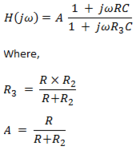Mitchy190
Newbie level 4
1. The problem statement, all variables and given/known data
I have for the attached circuit measured the amplitude and phase response, but the question I have to answer is too theoretically, derive, similar results and then compare the two methods. It is suggested to figure out the transfer function and plot the magnitude and phase response.

The component values are know, and are:
R1 = 47k
R2 = 4K7
C = 10nF
I am having difficulty driving the transfer function for this circuit and some much needed help would be appreciated!
2. Relevant equations
H(jω) = R2/(R2+(R1*1/jωC)/(R1+1/jωC))
3. The attempt at a solution
So far I have converted the circuit into 'standard form':
Z1 = R1, Z2 = R2, Zc = 1/jωC, Vin = Vip and Vout = Vop (p = Phasor)
and then I know that H(jω) = Vop/Vip
And knowing this I worked out that
Vop = (R2/(R2+(R1*1/jωC)/(R1+1/jωC)))*Vip
∴
H(jω) = R2/(R2+(R1*1/jωC)/(R1+1/jωC))
And this is where I am stuck. I'm not sure if this is the correct method to derive the transfer function, or even right at all, but this is just my thinking and attempt . So much help is needed
Thank you
I have for the attached circuit measured the amplitude and phase response, but the question I have to answer is too theoretically, derive, similar results and then compare the two methods. It is suggested to figure out the transfer function and plot the magnitude and phase response.

The component values are know, and are:
R1 = 47k
R2 = 4K7
C = 10nF
I am having difficulty driving the transfer function for this circuit and some much needed help would be appreciated!
2. Relevant equations
H(jω) = R2/(R2+(R1*1/jωC)/(R1+1/jωC))
3. The attempt at a solution
So far I have converted the circuit into 'standard form':
Z1 = R1, Z2 = R2, Zc = 1/jωC, Vin = Vip and Vout = Vop (p = Phasor)
and then I know that H(jω) = Vop/Vip
And knowing this I worked out that
Vop = (R2/(R2+(R1*1/jωC)/(R1+1/jωC)))*Vip
∴
H(jω) = R2/(R2+(R1*1/jωC)/(R1+1/jωC))
And this is where I am stuck. I'm not sure if this is the correct method to derive the transfer function, or even right at all, but this is just my thinking and attempt . So much help is needed
Thank you
